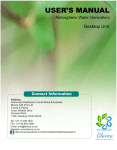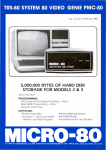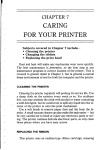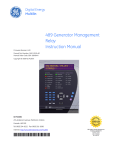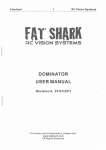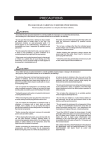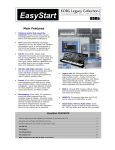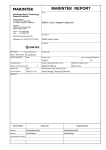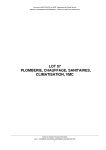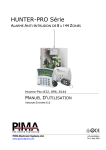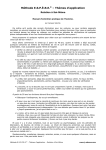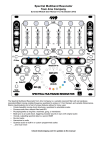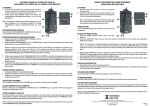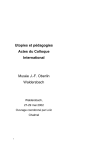Download Oberheim Matrix 12
Transcript
HARDWARE ^ v^ Oberheim Matrix 12 Programmable 12-Voice Multi-timbral Polysynth Oberheim's pricey but successfui Xpander gets a velocity-sensing keyboard and a doubling of voices. Suddenly, words are not enough. hen most manufaclurers were producing expanders as keyboardless versions of alreadyexisting synths, Oberheim surprised everybody by bringing out an expander with an entirely new spec. When thé sixvoice Xpander was unveiled at thé 1984 Frankfurt show, a 12-voice version with keyboard was already taking shape at Oberheim's R&D labs. It took a while coming, but now that it's hère, it looks set to affirm thé Californian company's position as thé premier makers of upmarket analogue polysynths. The instrument in question is thé Matrix 12, a 12-voice, touch-sensitive polyphonie synthesiser that employs thé same hardware and software soundgenerating éléments as thé Xpander module, and also shares most important design principles. So much so, in fact, that current Matrix documentation comprises an Xpander user manual and a brief Matrix 12 introductory guide. A quick comparison between thé Xpander and Matrix 12 front panels reyeals that_Oberheim hâve retained thé W 10 Simon Tra.sk former's highly successfui design layout, with just a few modifications necessitated by thé différence in number of voices. The block diagrams at thé right of thé panel tend to be a bit off-putting at first glance, but they do in fact provide a wealth of information about thé structure of each voice, how that structure is accessed via thé LED displays, and which éléments of each voice can be subjected to modulation. Sound Génération Basically, each voice comprises two VCOs, a multimode VCF, two VCAs, five Envelope Generators, one FM VGA, five LFOs, three Tracking Generators and four Ramp Generators. Of thèse, only thé two VCOs, VCF and two output VCAs are hardware, with thé remaining features being implemented in software to control thé hardware. Now, while thé hardware éléments are arranged in a fixed configuration, thé software bits and pièces can be arranged in any order you might wish to contrive. If you like, you can set them to control each other or even themselves. The source of this flexibility is Oberheim's Matrix Modulation System (of which more anon), which is probably best explained as a modern-day software équivalent of thé vast, sprawling synth patchbays of yesteryear. Anyway, for those of you who missed Paul White's review of thé Xpander (E&MM September 84), l'Il quickly run through Oberheim's version of what a top-end analogue synth System should contain. Each VCO is capable of generating triangle, sawtooth and puise waves individually or in cornbination. Puise width is adjustable, and VCO2 has an additional Noise input which may be mixed in. It's possible to sync VCO2 to VCO1 (ie. give it thé same pitch), in which case changing thé frequency of VCO2 produces a change of timbre. In fact, thé frequency of both VCOs is adjustable in semitone steps over a five-octave range, a Detune function is also available, and each VCO has its own VCA. JUNb isob •/HARDWARE/. Moving on to thé filter section (isn't it wonderful, getting back to familiar analogue Systems?), thé Oberheim's multimode filter allows sélection of any one of 15 filter modes, covering one-, two-, three- and four-pôle versions of ail filter types, plus selected combinations of thèse. In other words, a uniquely comprehensive filter section that only adds to thé Matrix 12's programming desirability. Frequency and résonance of thé filter are, of course, programmable, while thé final stage of thé hardware link is provided by two master VCAs. Additionally, it's possible to configure thé two VCOs in a carrier/modulator relationship for simple FM effects (though don't fool yourself into thinking you're going to get DX7 sound potentiel as a bonus feature - you aren't), with destination routable to either VCO2 or thé VCF. Other software-implemented éléments of each voice include five Envelope Generators, each with their own initial output level. Thèse are five-stage envelopes, adding an initial Delay (max 2.5 seconds) to thé familiar ADSR configuration. Longest attack time is around 16 seconds, while thé longest release runs to about 90, which should be enough for almost everybody, eccentric remix engineers included. And as if that wasn't enough, Oberheim claim that setting ail thé Envelope times to 63 (their maximum value), modulating each of them with a Tracking Generator set to 63, and switching on Freerun and DADR triggering modes results in an envelope cycle that runs about half-an-hour in length. Sad to say, though, I didn't actually check this to be accurate; pressure of deadlines, and ail that. But we still haven't finished. The remaining items are five LFOs (with programmable speed, waveform, and amplitude), three Tracking Generators (which enable various parameters such as filter frequency or amplitude to be tracked according to keyboard position), four Ramp Generators (for setting an overall 'rate of increase' for VCO1 or VCF frequency, say) and a Lag Generator (for portamento effects). Lastly, a number of triggering options (eg. single, multiple and external) are assignable to both thé Envelope Generators and Ramp Generators. Modulation Routing This is it. Computer technology's answer to thé spaghetti-heap wiring nightmare beloved of Tangerine Dream in days of yore. Its name? The Oberheim Matrix Modulation System. For every parameter that can be modulated on thé Matrix 12, there exists a Modulation Page. Each Page allows up to six modulation sources, each with their own modulation amount, to be assigned to any one destination parameter. And you can sélect any one of 27 différent destinations simpiy by pressing thé appropriate button in thé Modulation Source/X Select section on thé front panel. A maximum of 20 modulation E&MM JUNE1985 sources is permissible for each voice. Possible modulation sources include two levers, two pedals, attack and release velocities, and any of thé Envelope Generators, LFOs, Tracking Generators and Ramp Generators. A particularly handy feature - and one new to thé Matrix - is thé inclusion of a Modulation List for each single patch. This enables ail currently-assigned modulations to be viewed as one séquence, and quick altérations and deletions to be made in real time. But there are two problems hère. First, thé modulation source can't be changed from this Page, and second, if you exit and then return, you don't re-enter at thé point you left. Damn silly, if you ask me. Any modulation can be quantised into semitone steps, and modulation sources can either add or subtract from thé initial value (for a rise or fall in amplitude, pitch or filter cutoff frequency, for example). For something a little more dramatic, modulation sources can be directed to a destination more than once; an envelope Delay stage could be given greater duration in this way. And as if 20 modulations per voice wasn't enough, Page 2 of thé VCO and VCF sections allows further modulations of pitch and cutoff frequency. That should keep you quiet for a month or two... But no matter how many words you use to describe thé Oberheim's range of modulation options, they simpiy aren't sufficient to do justice to what is in essence an open-ended System. As a resuit, it's unlikely to meet ils match in terms of a programmer that can exhaust its potential, even if some of its more obscure possibilities aren't necessarily going to be of much musical value. I mentioned levers earlier on, and thèse black plastic contraptions are what Oberheim consider préférable to thé now almost universal pitch and mod wheels. And thé choice is a happy one. The levers are a lot easier to operate in tandem, and as a player more than used to wheel configurations (a situation an awful lot of players now find themselves in, l'd guess), I found getting acclimatised to Oberheim's System a surprisingly painless process. The only thing they could do with is some sort of serated top to make them easier to grab hold of, bul that's a small point, really. Voice Orchestration One of thé strongest features of thé Matrix 12 (potentially, at least) is its ability to 'map ouf voices on thé keyboard by means of what Oberheim call 'zones'; because Oberheim's approach goes well beyond thé split-keyboard and dualvoicing implementations of so many other instruments, and thé Matrix 12 has no fewer than six zones to be exploited by thé lucky user. Each zone can be defined as encompassing any area of thé keyboard, from as little as one note up to thé entire MIDI allowable range (which effectively allows thé physical range of thé keyboard to be much larger than it is). Each of thé Matrix 12's voices may be assigned to any single zone, and as each voice can be assigned its own patch and thé zones may be overlapped in any fashion, it's possible to build up a bewildering array of multi-timbral 'palettes', thé sheer scope of which défies description. Once you've assembled a spécifie configuration to your satisfaction, thé Matrix 12 has capacity for storing 100 of them; it's thèse palettes that become Multi Patches in OberheimSpeak. Further refinements, ail multi-patch spécifie, include volume, stéréo panning and transposition settings for each voice, while each zone can be assigned its own voice mode, allowing monophonie or polyphonie playing with various sorts of note priority. The icing on thé cake is that both single and multi patches can be combined in a 100-link chain, which has got to be good news for anyone contemplating live use of a Matrix. Sounds And so we corne to thé stock factory patches. The 100 Single patches are organised into 10 groups of 10 allied sounds, and thèse are titled Brass, Strings, Pianos, Rhythm Comps, Symphonie Ensemble, Pitched Percussion, ./HARDWARE/. Basses & Leads, Percussion, Effects and First Impression. Presumably, thé last group is intended for shop démo purDoses. Most impressive are thé Strings and Symphonie Ensemble sections. The string sounds don't hâve thé attack or thé ;larity of Yamaha FM strings, but then hat's not what Oberheim's programmers hâve set out to achieve. Generally weakest are thé Percussion sounds (a bit of careful tweaking on thé user's part would no doubt make them a mite more présentable), but by contrast, he Pitched Percussion sounds are a delight. Ringing FM sonorities put in an appearance on such sounds as 'Bello' and 'Carrilon', while one of thé E&MM tafffavourites, 'St Happi' (where dothey get thèse names from?), sounds like a oom full of striking clocks out of sync vith one another, and plays itself endessly as soon as you press a key. I Iways wanted an easy life... What's really daft is thé way thé preset multi patches don't quite eut it thé way he single patches do. Daft because as ve've seen, multi patches give you a lot nore in thé way of programming scope lan their single brethren. But it seems Oberheim's programming staff haven't eally corne to grips with thé system's nherent potential, and as a resuit, many f thé combinations are decidedly unmpressive. There are a few gems, though, like Jazztrio', 'Ode 2joy', and 'Lead Wah', /hich applies multiple modulations to ever 2 to give a pretty realistic Hendrix uitar sound, complète with wah-wah nd feedback. I kid you not. tem, velocity and pressure values can be used to modulate almost any parameter of a Matrix 12 voice. So for instance, as well as thé more usual amplitude and filter frequency assignments, you can choose to modulate FM amplitude, lag rate, LFO speed, and VCF résonance. Hearing is believing. Page Editinj Given thé complexity of ail thèse modulation options and possible zonal configurations, you'd be forgiven for thinking that thé Matrix 12 is a beast of an instrument to do anything with. Fortunately, this isn't thé case. The aforementioned block diagram of voice organisation, which takes up about a third of thé front panel display, gives a breakdown of each voice component, blues that currently grâce thé instrument's front panel - they aren't exactly an aid to visibility. As they did with thé Xpander, Oberheim hâve provided three 40-character, 14-segment fluorescent green LED displays on which (at last) a sensible amount of information can be displayed. Two of thèse Windows are located on thé centre panel in thé Page Modifier section, one being used to display thé selected parameters or functions, and thé other to display their associated values. An array of buttons under each window is used to sélect a f unction or a parameter, and a set of infinité rotary knobs sélects a new value. Sad to say, things get more complex when you corne to Multi Patch mode, because it's hère that a second set of Pages cornes into play. Thèse Pages are assigned appropriate names like 'Volume', 'Pan' and 'Zone X', and can be summoned forth into thé central display at thé touch of a button. But what's so nice about this way of doing things is that whole sections (consisting of up to six allied parameters) can be called into thé central display at any one time. From there, they can be simultaneously altered by twiddling a set <eyboard Sensitivity You might hâve a whole load of truly /onderful multi-timbral textures at your isposal, but will thé Matrix keyboard low you to use them to their best effect? Vell, thankfully, this particular Oberheim eyboard is touch-sensitive on ail three ounts, ie. attack velocity, pressure (also nown as after-touch), and release veloity, though pressure sensing is currently sadable oniy via MIDI, which is a pity. eyboard-based pressure sensing will, ccording to thé Opération Guide, be vailable as a retrofit at no charge in thé ear future, so that's some consolation, I uess. Five keyboard velocity scales are ssignable for both attack and release elocities, so you can adjust things finely suit your own touch. And as if that asn't enough, individual scales can ven be set to act upon MIDI input data. Thanks to thé Matrix Modulation sys12 and tells you at a glance exactly what you can and can't modulate. Thèse components are conceived as Pages, and are given stunning names like 'VCO1', 'FM/ LAG' and 'LFO X'. Each Page has a Page Select button adjacent to it, which is used to call thé associated parameters into thé LED Windows. The diagrams are a gréât help, make no mistake, but having said that, I reckon Oberheim could hâve chosen better colours than thé dull greys, greens and of six infinité rotary knobs. As PW pointed out last September, this is a much more helpful arrangement than thé digital parameter access System now almost universally employed by thé rest of thé synth industry. The reason for that is simple. Whereas most modem synths don't allow you to discover how altering more than one parameter value simultaneously affects thé sound, thé Oberheims do. And that's going to save a lot of people a lot of programming time. JUNE1985 E&MM IARDWARE, AH editing can be accomplished as you're playing, with any changes being registered immediately (ie. in real time). New settings are remembered no matter which Page you subsequently go to, and even through power-down, until a new patch is selected prior to storing. So, Oberheim hâve corne up with an access System that strikes a neat balance between thé economy of centralised displays and thé immediacy of dedicated controllers. I found I was able to access and aller any parameter very quickly, and thé new Modulation Page proved a tremendous help in dealing with that side of things. Interconnections Sad to say, it's in this department that thé Matrix 12 is somewhat lacking by comparison with thé Xpander. For thé moment, at least. But first thé good news. Carried over from thé Xpander are a memory protect switch (recessed, thankfully) and thé merry trio of MIDI In, Out and Thru sockets, plus cassette in and out connectors, two pedal sockets (capable of handling footswitches and footpedals), an 'advance chain' socket, a trigger in socket (with switchable polarity) and stéréo and mono outputs. However, gone are thé individuel CV/ Gâte inputs and audio outs that graced thé Xpander. Their omission wouldn't be so serious if thé Matrix were a budget poly of limited studio applications. But it aspires to be a good deal more than that, and seeing as Oberheim managed to give thé Xpander both CV/Gate connectors and individual audio outs, I can't for thé life of me think why they've left them off thé Matrix. The nice people at Turnkey assure me they're doing ail they can to get thé Californians to change their minds on this one, and I hope they succeed. And so to MIDI. Historically, Oberheim were initially fairly sceptical about thé virtues of thé new interface (and perhaps they still are), but there's no denying they've subsequently implemented it with a welcome thoroughness. Specifically, thé Matrix 12's MIDI implementation can be split into tnree areas: multi patches, global control and data transfer. Each zone within a multi patch can be assigned its own MIDI channel, or be set to Omni mode. Choice of MIDI transmission and/or réception is also zonespecific. If MIDI In is selected, thé zone responds to note and controller information, while if MIDI Out is selected, thé zone transmits notes received from thé keyboard and from MIDI In; controller information is only transmitted if you sélect thé appropriate option. A final provision, very necessary if zones are overlapped and one of them is only meant to be playing incoming MIDI data, can be brought into play to shut off keyboard input for any given zone. In case you hadn't already guessed, what ail thèse options add up to is a tremendously versatile system for configuring a MIDI setup, though I guess thé System will make even more people happy when thé CV/Gate inputs eventually matérialise. As for thé MIDI global control and data transfer options, thèse are accessed via thé Master Page. Global control consists of Basic Channel sélection, controller code allocation, scaled response to incoming velocity information, patch change transmission on/off, écho on/off (when this is on, Matrix data and MIDI In data are both sent to MIDI Out), Reset (turns off ail notes and returns thé instrument to a default MIDI condition) and Mute (turns off ail notes). Incidentally, controller code allocation can be seen as a software 'patchbay' used to connect MIDI controllers to thé local controllers of thé Matrix 12. Levers, pedals and pressure may ail be assigned any MIDI controller number between zéro and 121, or thé dedicated Bender and after-touch pressure codes. This is thé sort of flexibility you'd expect to find on a dedicated controller keyboard, though Yamaha's KX88 is thé only example that springs to mind at thé moment. Maybe Oberheim's own forthcoming XK controller will offer something similar. Whatever, combining thé flexibility of thé Matrix 12's internai modulation routings with its own comprehensive keyboard arrangement makes for a highly versatile MIDI system. The third area of MI Dl control concerns data exchange. 'SystemX' must be enabled before anything can happen on this front. You can send either a single or multi patch individually, or ail internai patches in one go, which takes about 20 seconds. Any Xpander owners out there might like to know that Matrix 12 and Xpander data are fully compatible with each other, and may be transferred in either direction but you'll need something in thé way of modification. Downloading from Matrix 12 to Xpander, for instance, will require Xpander Software Revision 1.3, available from your nearest chemist. Compatibility is also présent on thé tape storage front, which can't be bad. Conclusions Powerful enough to kick thé rest of thé band into thé ionosphère in a live situation, yet sufficientiy flexible to take pride of place in an above-average studio setup, thé Matrix 12 is everything a topnotch analogue poly should be and a fair bit more besides. Because apart from thé odd case of Retrofit Blues, Oberheim seem to hâve got everything right. UK distributors Turnkey already hâve takers for thé entire first batch of Matrix 12s, and thé review model only gained a temporary reprieve so that E&MM's readership could learn of thé instrument's many and varied synthetic delights. By combining thé best that analogue synthesis has to offer with one of thé smartest examples of microprocessorbased control of a musical instrument l've yet seen, Oberheim hâve corne up with a keyboard that deserves to set not just one standard, but a whole slew of them. If you can afford thé Matrix 12, go for it. If you can't, you're in for a long wait before any secondhand bargains corne along... • RRP of thé Matrix 12 is £5200 plus VAT. Further détails from: Turnkey, Brent View Road, London NW9 7EL & 01-202 4366. E&MM JUNE1985 13





